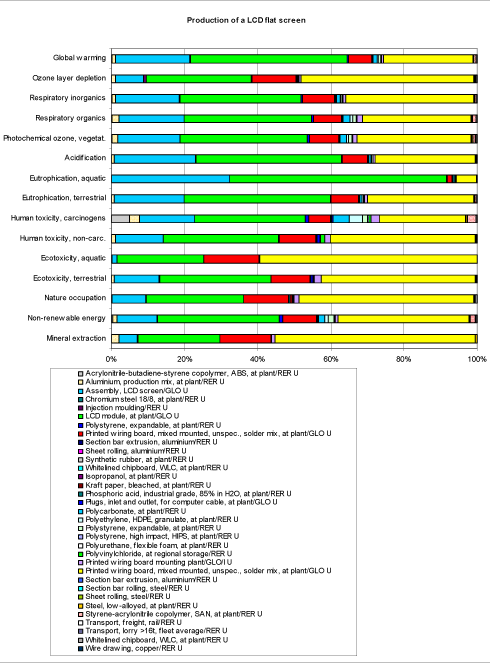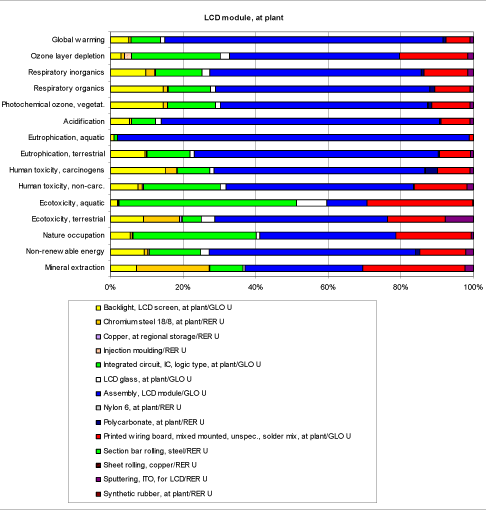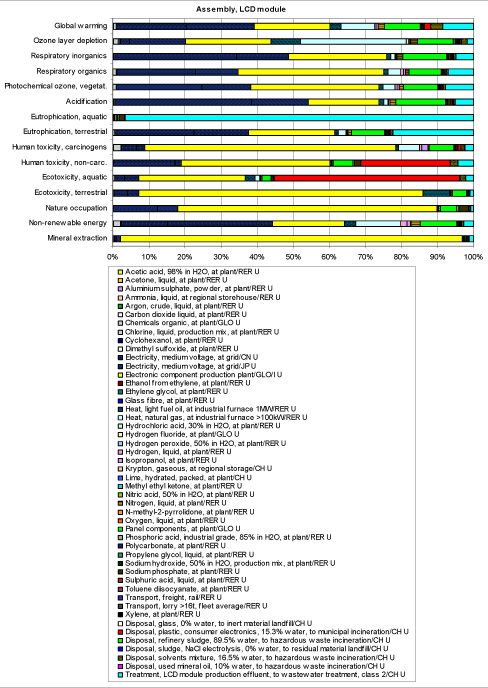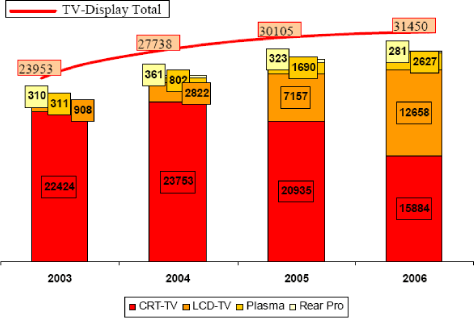Environmental Screening and Evaluation of Energy-using Products (EuP) Final Report
7 Consumer electronics: Televisions (Lot 5)
- 7.1 Background
- 7.2 Environmental screening based on the Ecoinvent database
- 7.3 Ecolabel requirements
- 7.4 Technology and market trends
- 7.5 Conclusion
7.1 Background
The term television (TV) refers to a wide spectrum of products depending on the system boundaries we apply. The term has come to refer to all the aspects of televisions from the television devices (TV-set), television related equipment (e.g. TV/video combinations), up to the complete television broadcasting and receiving system including:
- An image source - this may be a camera for live pick-up of images or a flying spot scanner for transmission of films.
- A sound source.
- A transmitter, which modulates one or more television signals with both picture and sound information for transmission.
- A receiver (television) which recovers the picture and sound signals from the television broadcast.
- A display device, which turns the electrical signals into visible light and audible sound.
TVs are the largest electricity consuming appliance in the residential sector. Total sales of TV continue to grow, and reached 30 million in 2005 [IES2007]. It includes traditional equipment such as TVs and Hi-Fi, as well as new devices such as MP3 players, PVRs etc. In this sector there is a fast turnover and technological development, which could change the energy consumption.
7.2 Environmental screening based on the Ecoinvent database
There are no Ecoinvent data on televisions. However, it has been assumed, that all future televisions have LCD-screens. Accordingly, LCD-monitors from computers have been used as a proxy for the product category “televisions”.
The conclusions for the environmental screening of the LCD-screen are:
- The main environmental impacts come from the printed wiring board, the assembly of the LCD-screen and the production of the LCD-module.
- The main impacts from the production of the LCD-module mainly come from the assembly of the LCD-module, the printed wiring board (in the LCD-module), the integrated circuit (in the LCD-module) and from the production of the backlit to the LCD-screen.
- The main contributions to the assembly of the LCD-module come from electricity production and production of electronic components.

Figure 7.1 Environmental impacts from the production of a LCD flat screen.

Figure 7.2 Environmental impacts from the production of the LCD module.

Figure 7.3 Environmental impacts from the assembly of the LCC module.
7.3 Ecolabel requirements
European policies to improve TV efficiency were introduced starting from 1996 and initially covered only standby losses. The first measure was the TVs and VCRs standby losses unilateral agreement which was signed in 1997 by 16 companies and notified to the competition authorities by the consumer electronic trade association (at the time EACEM, now EICTA). Manufacturers agreed that the company sales-weighted average would be progressively reduced towards 3 W by 2009. The target refers to the company sales-weighted TVs and VCRs stand-by consumption. Models with standby consumption over 10 W were to be phased out. In 2003 already sale-weighted average power consumption of 2.21 W and 3.53 W was achieved for TVs and VCRs respectively.
The European Ecolabel from 2002 [EC2002] for televisions focuses on:
- Energy consumption
- Life time extension: The availability of compatible electronic replacement parts shall be guaranteed for 7 years from the time that production ceases.
- Take-back and recycling systems (arranged by the manufacturer).
- Design for recycling.
More recently EICTA (the European Industry Association for Information Systems, Communication Technologies and Consumer Electronics) submitted in 2003 to the European Commission a new Self Commitment (unilateral commitment), signed by the a large number of the their member companies, to reduce the energy consumption of consumer electronics by continuously seeking to improve the energy performance per appliance.
7.4 Technology and market trends
TVs are the largest electricity consuming appliance in this sector. Total sales of TV continue to grow, and reached 30 million in 2005 [IES2007]. However, CRT TVs and VCRs are sharply reducing their sales in favour of flat TVs and DVDs as can be seen from the GfK market research presented in Figure 7.4 on the following page.
However, the shift from CRT TV’s to LCD TV’s does not necessarily mean that the total energy consumption decreases. Recent research indicates that households move the old TV to other rooms and in many cases operates two or more TV’s simultaneously. This assumption is backed by the increased penetration in households and the increased number of viewing hours. Referring to the year 1995 GfK found the number of viewing minutes on TVs increased with 13% (27 minutes more per day) till 2005.

Figure 7.4 Number of TV's sold per type. (Source: The GfK market research group (www.gfk.de))
Many new TV models have now standby consumption well below 1 W, some companies have introduced a company policy to have all their models below 1 W. For VCRs the best appliances have a standby consumption around 1 W (eco-mode), many have standby consumption around 2W, however, it must be noted that VCRs sale are decreasing very rapidly. For DVD players (which take the place of VCRs on the market and are experiencing a boom in sales) standby passive of best appliances is below 0.5 W. More recently policy makers’ attention has been drawn to the television on-mode consumption, due to increase in viewing hours and the size of the TVs.
In order to compare on-mode consumption of TVs having the same size and features (TV consumption is strongly related to the size), an Energy Efficiency Index (EEI) has been developed by industry EICTA and experts. However, data on TVs’ EEI is still very limited because most manufacturers do neither indicate the energy efficiency index nor the power consumption in the on-mode.
Conversion to digital broadcasts is perhaps the most significant issue with regard to future environmental impact and energy consumption associated with televisions. Most governments around the world have announced the conversion of free-to-air television services from analogue to digital broadcasts. The main consequence of concern is the legacy of installed analogue televisions and how they will operate in a digital broadcast future. The short and simple answer is the digital converter – this is a digital receiver that can convert digital broadcasts into a suitable analogue signal which can continue to be viewed using existing equipment (often called a set top box). Another result of the conversion is the increased WEEE from old analogue television sets being replaces by new units, mostly because of convenience on behalf of the consumer (to avoid set-top boxes or because it is desirable to move to flat screen technology). Please se chapter 18 and 19 for further discussion on this subject.
7.5 Conclusion
The authors believe that the environmental impact from televisions is substantially the same as the environmental aspects that are important for personal computers. This is especially true as the convergence of media accelerates culmination with the complete convergence of the High Definition TV (HDTV) and the computer.
7.5.1 Environmental impact in a system and life-cycle perspective
The main contributions to the overall environmental impacts come from the electricity consumption during use of the television. The electricity consumption is the main contributor to all the environmental impacts, but for “Mineral extraction”.
However, what is interesting is that even when including the energy consumption during use, the production of the hardware is quite significant for the overall environmental impact. From the production of the hardware, it is especially the energy for the production and eco-toxicity impacts from heavy metals (arising during the extraction of materials for the components and during the production of the hardware - e.g. emissions of Copper, Zinc, Nickel, Mercury, Chromium, Lead, Arsenic, Cadmium and Cobalt).
Improvement options regarding life-time extension are important (designing televisions for easy change of important parts). Design for reuse of components and recycling of materials from televisions should be highly prioritised.
Waste handling and incorrect recycling methods (especially in developing countries) constitutes a huge environmental problem. Depending on the weight put on to this issue, it might be the most important environmental aspect of televisions. Due to the short life-time, the end of life (disposal / dismantling for recycling / reuse in developing countries) is very significant for the overall environmental impacts of the products. Incorrect recycling of TVs may also lead to huge environmental impacts.
7.5.2 Environmental perspective from new technologies
New trend on the market having an important impact on energy consumption are larger screen sizes and plasma TVs, which use considerable more energy (350-400 W, but new developments can decrease this to less than 300 W). Smaller LCD TVs typically have an EEI of 0.4. Larger LCD TVs tend to have the same consumption as CRT TVs. The best CRTs on the market have an EEI of 0,995. Finally, prospects for improving efficiency in LCD TVs are better than for improving efficiency in CRT TVs, in particular by introducing solid state lighting in the backlighting systems.
7.5.3 Regulation
The end of life of televisions will be influenced by the WEEE directive and its future revisions and the use of hazardous substances in the products will be covered by the RoHS directive and its future revisions.
Version 1.0 December 2009, © Danish Environmental Protection Agency